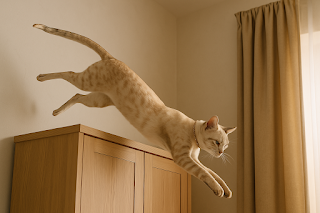Myth Busting Monday: Debunking Feline Fall Myths
But is that really true? Or is it one of those old myths that just sounds true because cats are so darn agile?
Let’s dive nose-first into today’s Myth Busting Monday, where we separate cat facts from cat fiction - without a scratch.
The Reflex Behind the Myth: Righting Reflex
Understanding the Righting Reflex
When a cat begins to fall:
1. They
twist their head and upper body to face downward.
2. Their
lower body follows the rotation.
3. They spread
their legs and arch their back to slow the fall — acting like a furry
parachute.
This complex mid-air maneuver makes it look like cats are invincible
- If a cat falls from too low a height (like a table), it might not have enough time to fully flip before impact.
- If the cat is elderly, overweight, or has a medical issue, its reflex might be slower or impaired.
- If the fall is from an extremely high place (like the 4th story of a building), yes, they might land on their feet, but the impact can still cause serious injuries, broken bones, lung bruising, or worse.
So while landing on their feet is common, it's not guaranteed.
What Happens When They Don’t Stick the Landing?
Common injuries from falls include:
- Fractured jaws or limbs
- Bruised lungs (pulmonary contusions)
- Dislocated hips
- Internal bleeding
- Spinal trauma
- Facial trauma, especially if the paws don’t hit first
Wild, right?
Science Check: Why Are Cats So Good at Falling?
Cats come with some built-in features that make them mini parkour champs:
- Flexible spines - Their vertebrae are loosely connected, giving them a noodle-like ability to twist mid-air.
- Great balance - Their inner ear structure gives them a top-tier sense of orientation, helping them figure out which way is up.
- Low terminal velocity - Thanks to their small size, light weight, and body fluff, they fall slower than most animals their size.
- Limber shoulders - No collarbones means their front legs have crazy range, perfect for mid-air acrobatics.
- Auto-adjust mode - They instinctively tuck and stretch their legs like little aerial yogis to rotate their bodies just right.
- Paw-some shock absorbers - Their soft paw pads and ability to spread out help cushion the landing like nature’s built-in parachute.
It’s basically physics + evolution = feline acrobatics.
What You Can Do as a Pet Parent
- Keep windows screened - Especially if you live in a high-rise apartment
- Secure balconies - Even the most cautious cat might chase a bird or bee right off the edge
- Avoid risky indoor setups - If your cat loves climbing wardrobes and shelves, create safer paths or padded landings
- Avoid placing furniture near windows that cats might climb onto it
- Provide safe indoor enrichment like cat trees and shelves that don’t pose a fall risk.
- Watch for signs of injury after a fall, even if your cat seems fine at first. Cats hide pain well.
- Regular vet check-ups can help spot any pre-existing conditions (like arthritis or vision issues) that could increase fall risk.
When to Call Your Vet
Even if your cat lands on their feet, call your vet immediately if
they:
- Limp or
refuse to walk
- Seem
disoriented or unusually quiet
- Have
labored breathing
- Show
swelling or visible injuries
Your vet may perform X-rays or other diagnostics to rule out internal damage.
Zoonotic Angle: What Does This Have to Do With Humans?
This myth might not be zoonotic, but it highlights the
importance of environmental safety for pets, which overlaps with human safety. For
instance, loose screens or open ledges pose risks not only to cats but to small
children or even adults in high-rise homes.
A safer home for your cat = a safer home for you.
Final Verdict: Myth Busted (Kind of)
Next time you see your cat eyeing the top of the fridge like it’s Mount Everest, remember: even the most elegant of acrobats can slip up.
Let’s Chat!
Stay tuned every Monday for more myth-busting facts from The Vet Vortex.
Check previous post - 10 Common Livestock Health Issues Every Pet Owner Should Know


